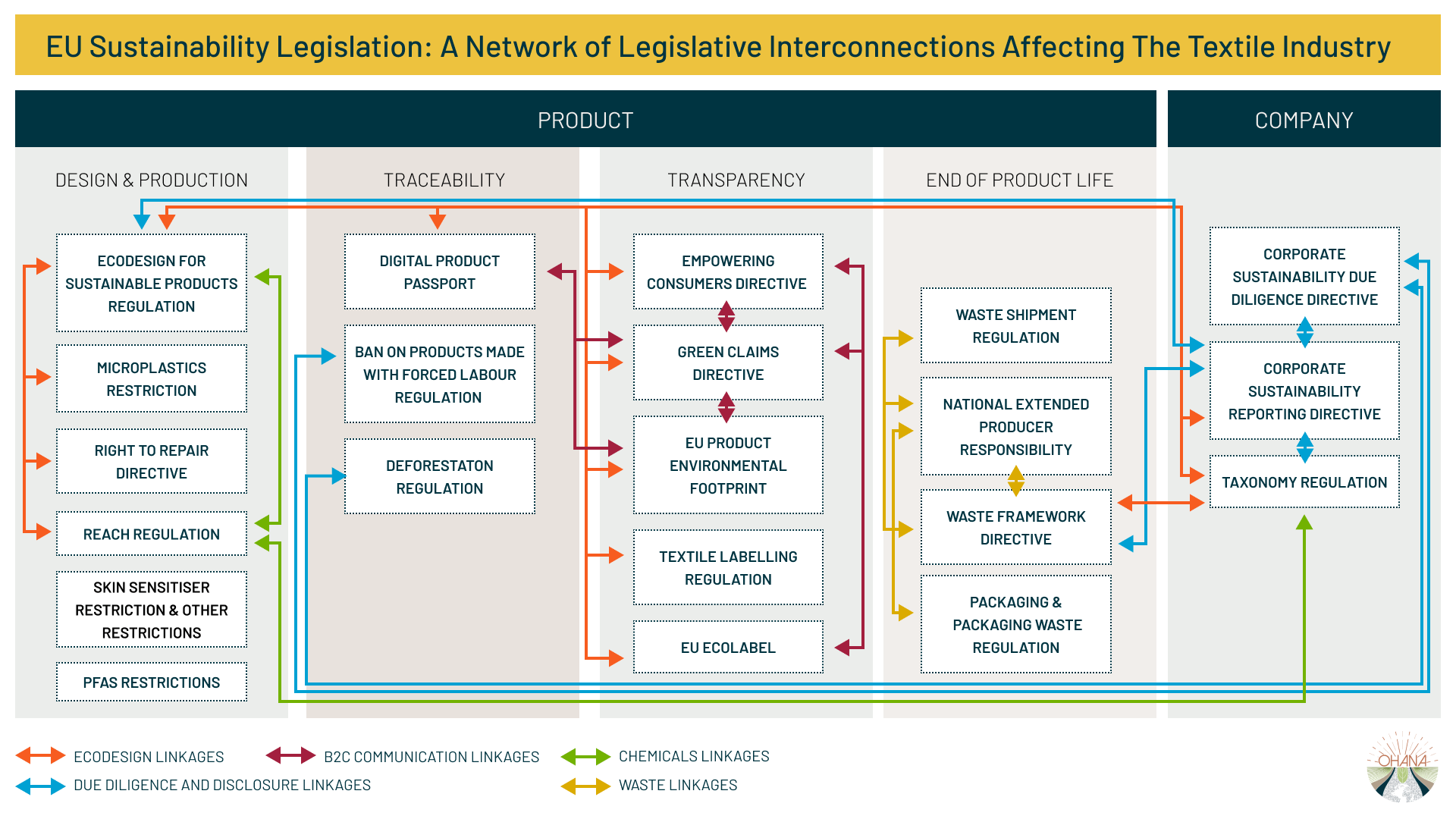The EU Corporate Sustainability Reporting Directive (CSRD) is no longer a distant policy on the horizon. Back in 2021, we wrote about how to prepare for the CSRD while it was still under negotiation, and highlighted its potential to reshape corporate reporting across Europe.
Now, with the directive adopted and in its implementation phase, it’s time to discuss what the final version of the CSRD means for EU companies and their supply chains.
However, in this article, I will go beyond providing you with an update on the CSRD. In addition to discussing the main aspects of the directive, we will look at its connection with other key EU policies, and what both businesses and suppliers can do to turn this potential challenge into a competitive advantage.
Want someone with deep experience and connections in the EU to help guide your sustainability strategy? Get in touch!
What Is The CSRD?
Adopted in 2023, the CSRD is a significant step in the European Union’s ambition to drive sustainability within the corporate sector. It introduces a robust set of reporting obligations for large companies, replacing the Non-Financial Reporting Directive (NFRD). The scope of the CSRD goes beyond large EU firms and applies to non-EU companies with a significant presence in the EU market. At its core, the CSRD requires companies to provide detailed sustainability information, integrating environmental, social, and governance (ESG) factors into their annual reporting.
This is in perfect alignment with the EU’s plan to enhance European businesses’ commitment to sustainable growth, climate change mitigation, and human rights protection.
In a nutshell, the CSRD will enhance business transparency, ensuring that investors, consumers, and stakeholders have access to accurate and comparable information about companies’ sustainability performance.
Scope And Implementation Timeline
The CSRD applies to large companies meeting at least two of the following criteria:
- Over 250 employees
- €40 million in net turnover
- €20 million in total assets
It also covers listed companies, including SMEs, but not micro-enterprises.
Geographically, it applies to companies based in the EU, but also to non-EU companies with significant operations in the EU. This means those with a net turnover exceeding €150 million in the Union, and with at least one subsidiary or branch within its borders.
The implementation of the CSRD will be phased to offer businesses some time to adapt. The timeline is as follows:
- 2025: The largest listed companies (those already subject to NFRD) must start complying with the new reporting standards
- 2026: Large companies with over 250 employees or a turnover exceeding €40 million must report
- 2029: Listed small and medium-sized enterprises (SMEs) will follow suit, although they benefit from simplified reporting obligations and Non-EU companies with significant turnover in the EU market
CSRD and Other EU Policies: Why a Holistic Approach to Compliance is Key
As you can see in the infographic below, the CSRD is not an isolated piece of legislation — it is part of a broader regulatory framework designed to enhance corporate accountability and sustainability across the EU.

I believe it is essential for businesses to understand how this directive interacts with other policies, such as t the Corporate Sustainability Due Diligence Directive (CSDDD), the upcoming Green Claims Directive, the EU Taxonomy, the EU Forced Labour Regulation, and the Digital Product Passport. Since these initiatives share common objectives, their compliance requirements often overlap and reinforce each other. That being the case, taking a siloed approach — where each regulation is treated as a separate compliance task — can create inefficiencies and risks.
For example, the CSRD requires transparency and disclosure of company impacts, risks and opportunities, while the CSDDD demands conducting due diligence on the adverse social and environmental impacts in the supply chain. The compliance with one will feed into the compliance with the other. Attempting to comply with these regulations independently could lead to duplicated efforts, gaps in data collection, or missed opportunities for a holistic sustainability strategy. Among other things, by connecting the dots between these regulations, businesses will be able to streamline their compliance efforts, build more resilient systems, and ensure consistency in their reporting.
Understanding The CSRD’s Disclosure Requirements
The CSRD adopts a certain novelty, the double materiality principle, meaning companies must report on two key areas:
- The impact of their business activities on society and the environment, such as their carbon footprint, biodiversity impacts, and social contributions.
- The impact of sustainability issues on the business itself, including how climate change or social factors affect their financial performance and business model.
The reporting categories under the CSRD are broad, encompassing:
- Environmental factors (e.g., climate emissions, pollution, circular economy practices)
- Social and human rights aspects (e.g., labour practices, community impacts)
- Governance issues (e.g., internal policies, ethical business practices)
Examples of disclosure requirements
To provide a concrete example, here are some disclosure points on which companies will have to report regarding their climate impact:
- Internal transition plans (e.g., outlining targets and how they align with the Paris Agreement);
- Emission reduction targets by 2030 and 2050;
- Greenhouse gas emissions under scope 1, 2 and 3;
- Total energy consumption mix;
- Greenhouse gas removals in their own operations, plus upstream and downstream in their value chain.
CSRD Reporting Standards: Facing the Challenge of Traceability
To ensure comparability, transparency and consistency, businesses must report using the European Sustainability Reporting Standards (ESRS), which provide detailed guidance on what needs to be reported and how. These standards cover over 200 specific reporting points, which makes complying with the CSRD a complex and resource-intensive task, particularly for businesses with extensive supply chains.
The biggest challenge I see for businesses lies in traceability. To comply, companies must be able to track key data across their operations and that of their suppliers, regardless of location. Given these requirements, the pressure on companies to gather accurate and timely data will be immense. Businesses must now develop standardised ways of requesting information from their suppliers to ensure that data collection is consistent and reliable.
Recommendations: How Companies and Suppliers Can Prepare
The CSRD’s focus on value chain reporting means that even businesses not directly subject to the directive will feel the pressure. So my recommendations of how to prepare for what’s coming are both for affected companies and suppliers.
Recommendations for Companies
- Start Early: Implementing the CSRD reporting requirements is a complex process that requires internal coordination and new data collection practices. This means companies should be taking immediate action, even though the CSRD’s implementation will be phased.
- Invest in Technology: To meet traceability and reporting requirements, companies should invest in software and digital tools that streamline data collection and reporting processes.
- Engage Your Supply Chain: Since much of the data required under the CSRD comes from supply chains, companies must communicate often and collaborate closely with suppliers, to ensure compliance at every stage of the operation.
- Establish Cross-Functional Teams: Sustainability reporting should not be relegated to one department. Finance, procurement, legal, and sustainability teams must work together to ensure an integrated approach to reporting.
Recommendations for Suppliers
- Enhance Transparency and Processes: Suppliers will increasingly be asked to provide detailed information about their production processes and ESG performance. Those who can do so efficiently will become preferred partners for businesses subject to the CSRD.
- Invest in Sustainability: Meeting CSRD-related demands isn’t just about compliance — it is also an opportunity to attract new business and strengthen relationships with EU-based companies.
Advantages of Early Implementation
Early implementation will provide companies with more time to identify and address gaps in their sustainability performance, reducing the risk of non-compliance and potential penalties down the line. And this is not only in relation to the CSRD. For example, enhancing communication and tracking efforts will prepare brands and suppliers for compliance with the upcoming Digital Product Passport – another EU initiative where traceability will be absolutely key.
But that’s not all. Having a robust sustainability reporting system in place can open up new business opportunities also for EU companies, particularly as ESG criteria become increasingly important in public procurement and investor decision-making.
At Ohana Public Affairs, we specialise in helping businesses smoothly navigate the complexities of EU legislation, so get in touch! Our experts will work with you to design a tailored strategy to ensure compliance with the CSRD and other related policies, but also give your business a significant competitive edge.
Want someone with deep experience and connections in the EU to help guide your sustainability strategy? Get in touch!
Join our newsletter to keep up to date with the latest news and information coming out of the EU.


